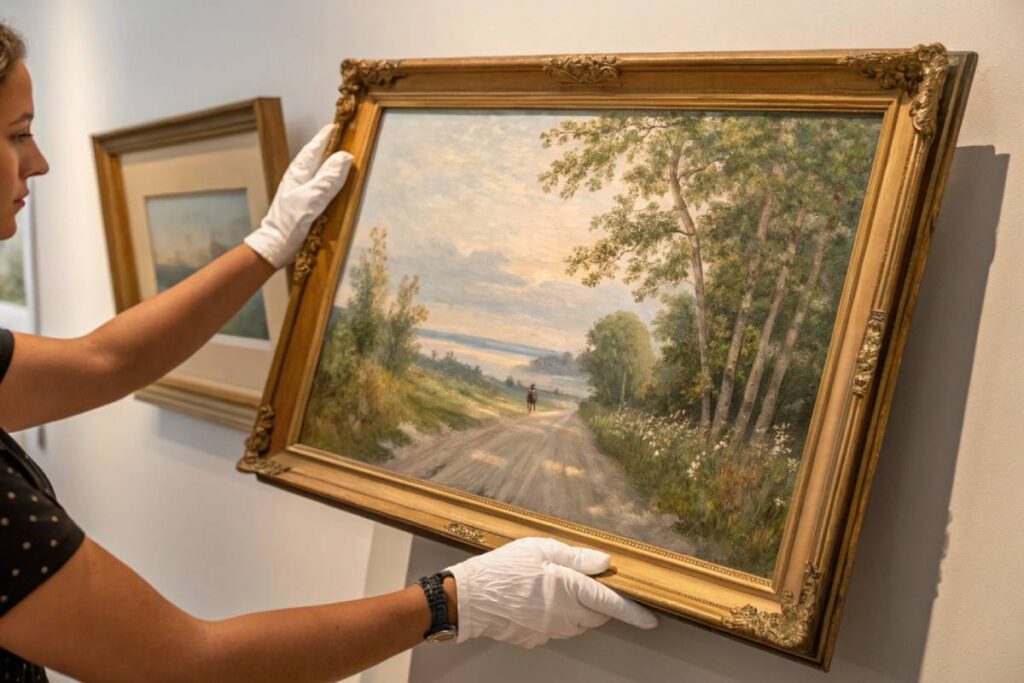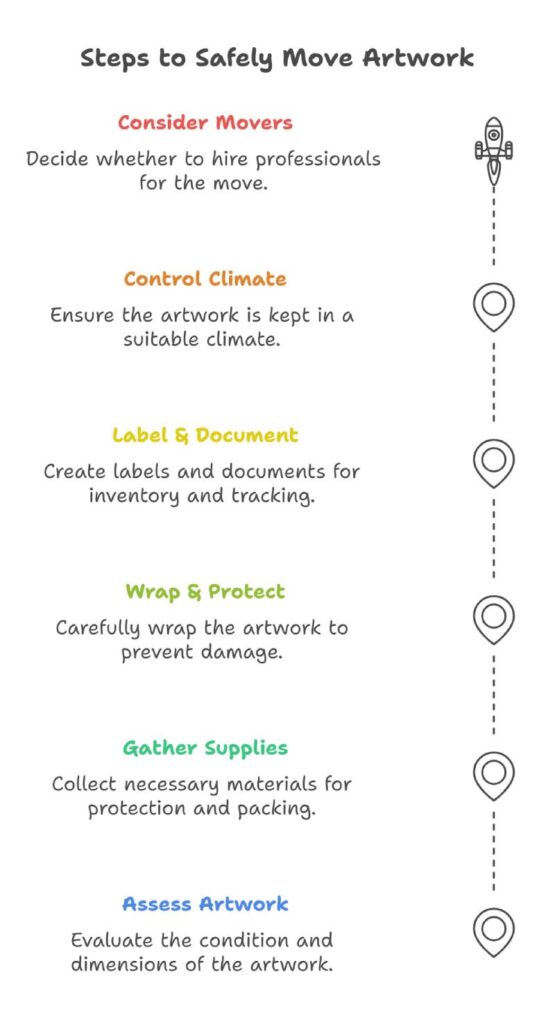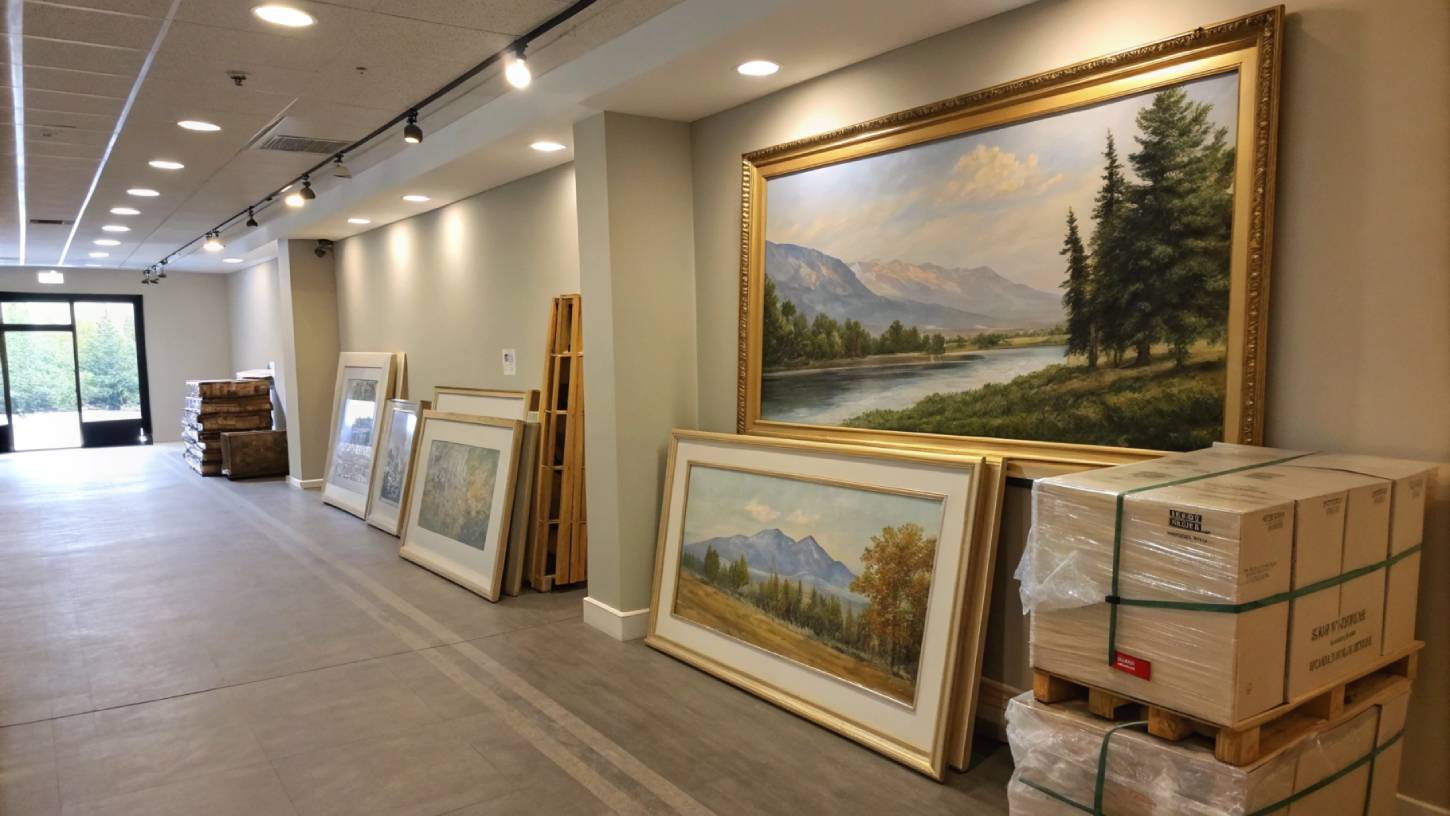Moving valuable artwork from one home to another can feel like transporting delicate treasures across a high wire. Whether you’re a dedicated collector, a museum curator, or simply cherishing a single, beloved piece, the stakes are high.
A careless bump could turn priceless paintings into nothing more than sad smudges, while subtle climate changes can quietly warp what once shined with vibrant detail. This guide shows you how to pack, protect, and preserve your art.
From assembling the right materials and documenting each piece’s journey to working with seasoned pros, you’ll learn how to move your art confidently, safely, and beautifully.
Safeguarding Your Artwork
Keeping your art safe when you’re moving is a big deal if you want to keep it looking like a million bucks. Art lovers, museum folks, and anyone with valuable pieces need to plan a bit before shifting treasures to a new spot.

Importance of Properly Moving Artwork
Taking good care of your art while moving makes sure it shows up without a scratch. Mess it up, and you might end up with pricey wall hangings that suddenly aren’t worth much anymore. Whether you’re just moving your favorite painting or packing up an entire collection, being careful is the name of the game.
| Why Move Art Carefully | What Could Go Wrong |
|---|---|
| Keeps it in mint condition | Cracks and tears galore |
| Holds onto its cash value | Loses value from damage |
| Stays easy on the eyes | Loses its visual charm |
| Guards that personal touch | Gone forever sentimental worth |
Understanding the Risks Involved
Art is fragile and moving it is risky without the right know-how and tools. First up, we’ve got to think about physical threats. Paintings and sculptures can get scraped, dinged, or worse during a move if you’re not super careful.
Then, there are the sneaky dangers of the environment. Stuff like changing temps and humidity can warp or mess with your artwork’s health. This means thinking about climate control is part of the moving plan too.
And let’s not forget getting the art from A to B: transport can be a nightmare. You’ll need solid loading and securing strategies to stop your art from getting tossed around or slipping out.
| Risk Type | What Might Happen to Art |
|---|---|
| Physical Hazards | Riddled with scratches, dings, cracks, and stains |
| Environment Twists | Warping, color fading, falling apart |
| Awkward Handling | Dropped or packed wrong |
| Transit Troubles | Shaken, stirred, and out in the elements |
By thinking ahead about these risks and playing your cards right, you can move your art without the drama. If you want a heads-up on how to juggle special items, peek at our tips on specialty movers for antiques and moving home office equipment.
Preparing for the Move
Getting your artwork ready for the road is kind of like preparing a delicate soufflé. You gotta give it attention and make sure all the tiny details are just right, so everything lands safely and sound as a bell.

Assessing Your Art Collection
Before you start wrapping up your art like it’s a holiday affair, take a minute to really see what each piece needs. Think about the size, how hefty or frail it might be, and jot down any reminders. Here’s the skinny on what to check:
| What to Look At | What to Remember |
|---|---|
| Size | Measure your art top to bottom, side to side |
| Weight | Heavy stuff deserves tough materials |
| Fragility | If it could snap like a twig, take extra care |
| Material | Each type’s got its own packing tricks |
| Value | Pricier pieces might appreciate a little extra insurance love |
Curious about moving insurance? Scoot over to our guide on insurance for moving valuables.
Gathering Necessary Supplies
Without the right gear, your art might as well be traveling in a paper bag. Stock up on these packing superheroes before you even think about moving:
- Bubble Wrap: Like hugging your art, only better.
- Packing Paper: Perfect for bundling up paintings and delicate bits.
- Corner Protectors: Keep the corners crisp and safe.
- Foamboard: A perfect buffer for all those bumps in the road.
- Moving Blankets: Extra softness for your larger, more fragile pieces.
- Packaging Tape: The duct tape of the art moving world.
- Cardboard Boxes or Crates: Sturdy enough to hold your masterpieces.
- Permanent Markers: ‘Cause nothing’s worse than a box without a label.
For a bigger haul of gear ideas, peek at our packing materials for valuables.
By giving your collection some TLC and making sure you’ve got the right materials on hand, you’re setting up for a move as smooth as silk. For those priceless or particularly bulky bits, you might wanna call in the pros – don’t miss our tips on specialty moving crates and moving large sculptures.
Packing Artwork
Getting your precious artwork ready for moving day isn’t just about having the right dance moves—it’s about making sure your pieces arrive in one piece! Grab the right gear and master a few tricks of the trade, and those masterpieces will travel safely like seasoned explorers.
Materials for Wrapping and Packing
Picking the right materials feels a bit like assembling an art-saving toolkit. Different cases call for different weapons in your packing arsenal.
| Material | What It Does |
|---|---|
| Bubble Wrap | Keeps everything comfy and cosy |
| Foam Sheets | Extra snug with a layer of protection |
| Acid-Free Paper | A safe hug that keeps bad chemicals away |
| Corner Protectors | Your sharp corners’ BFFs |
| Packing Tape | The trusty sidekick holding things together |
| Cardboard Boxes | A protective shell |
| Specialty Moving Crates | Armor for the big fellows |
Need a shopping list for packing supplies? Check out our article on packing materials for valuables.
Techniques for Protecting Fragile Pieces
Here’s where technique becomes an art. These steps help dodge disaster like a pro!
Steps for Packing Framed Artwork:
1. Wrap in Acid-Free Paper:
- Give your artwork a chemical-free cocoon with acid-free paper.
2. Apply Bubble Wrap:
- Layer up with bubble wrap, with bubbles looking outwards to create a cozy fort.
3. Attach Corner Protectors:
- Fix up corners, making them ready for unexpected encounters.
4. Seal with Packing Tape:
- Bundle it all up nicely, but don’t squish it too much!
Steps for Packing Unframed Artwork:
1. Roll with Tissue Paper:
- Gently roll up your masterpiece in acid-free tissue paper to prevent an awkward creasing incident.
2. Insert into a Mailing Tube:
- Slide the rolled up artwork into a robust tube, making sure it fits just right.
3. Seal the Tube:
- Cap the ends tight with plastic, then tape it like it’s going out of style.
When your task involves moving mammoth sculptures or other artistic giants, specialty moving crates are your go-to solution for a snug fit.
For extra tips on handling fragile treasures, such as your grandma’s porcelain—or her epic art collection—head over to our article on packing fragile glassware.
Packing artwork is all about the perfect blend of the right materials and solid techniques. Dance through these steps like a pro, and your art will arrive at its new home safe and ready to grace its new space with a splash of elegance.
Labeling and Documenting
When you’re hauling art, getting those labels right and documenting each piece is like wrapping your prized treasures in a big old safety blanket.
Importance of Proper Labeling
Labeling isn’t just about sticking a name tag; it’s about making sure these works of art get the TLC they need. Labels should scream out crucial details like fragility and how to handle them with care.
- Fragility: Make it loud and clear when something is breakable.
- Orientation: Guide the movers on which way is up (e.g., “This Side Up”).
- Handling: Spell out any special care instructions.
For that extra-fancy, easily damaged pieces, splurge on some top-notch packing materials for valuables. It’ll be worth it.
| Label Type | Purpose | Example Labels |
|---|---|---|
| Fragility | For fragile items | “Fragile,” “Handle With Care” |
| Orientation | Shows which end’s up | “This Side Up,” “Top” |
| Handling | Provides specific instructions | “Keep Dry,” “Do Not Stack” |
Documentation for Insurance and Tracking
Writing down your art info isn’t just for kicks; it’s crucial for insurance and keeping tabs during the move. This way, you won’t risk your precious collection vanishing into thin air.
Inventory List
Make yourself a trusty inventory list with:
- Description: Include the nitty-gritty details about the art, like size and medium.
- Value: Put a price tag on each piece for insurance.
- Condition: Jot down its current state pre-move, and snap some photos too.
| Piece Name | Description | Estimated Value | Condition |
|---|---|---|---|
| “Sunset Bliss” | Oil on Canvas | $1,500 | Excellent |
| “Abstract Dreams” | Mixed Media | $2,000 | Good |
| “Historic Mantra” | Watercolor | $3,500 | Fair |
Thinking about insurance? Scroll through our guide on insurance for moving valuables for all the deets.
Tracking Information
You wouldn’t send a kid off to camp without his name on his underwear, right? The same goes for your art. Here’s what you’ll need:
- Shipping Labels: Everything from where it’s going to whom it’s going to.
- Tracking Numbers: Save those tracking numbers like they’re winning lottery tickets.
- Contact Information: Double-check that contact info is right, both for you and the receiver.
Transporting other treasures like vintage cars? Make sure you account for those quirks. Check out guides on shifting specific items like classic car moving services and moving musical instruments.
By slapping on the right label and documenting like a pro, you’re rolling out the red carpet for a smooth move. All those masterpieces will stay perfect from point A to point B.
Transporting Artwork
Keeping your prized art safe while on the move is a task worth doing right. With the right approach and methods, your artwork will reach its destination as flawlessly as it left.
Choosing the Right Moving Method
The ‘how’ of moving your art depends on stuff like how far you’re going, how big the art is, and how fragile it might be. Here’s the rundown:
| Method | Description | Best For |
|---|---|---|
| Your Own Car | Short trips, easy-peasy | Smaller, harder-to-break pieces |
| Pro Movers | For the big leagues and miles | Big, costly, and delicate bits |
| Art Specialists | The art-moving maestros | Pricey collections, museum stuff |
Got a serious journey ahead or are you dealing with super delicate stuff? Specialty movers for antiques are your pal. They’re like the bodyguards of the art world, knowing just what delicate treasures need.
Secure Loading and Unloading Practices
Get the loading and unloading right, and you’re halfway there. Here’s the scoop:
- Gear Up: Dollies, straps, padding — your moving arsenal.
- Settle it In: Make sure everything’s snug as a bug on the trip.
- Easy Does It: Every piece deserves a gentle touch, maybe more. Proper packing materials for valuables help too.
| Step | Practice | Tip |
|---|---|---|
| 1 | Tool Up | Keep blankets in your kit for some extra softness |
| 2 | Get it Safe | Heavy stuff on top? Nope, don’t do it |
| 3 | Handle Gently | Always lift from the bottom, trust us |
Don’t forget the labels; mark those boxes “Fragile” and show which side’s up. It’s like giving directions to not mess things up.
Try specialty moving crates if your art needs more than just packing tape. These are custom-fit just for your stuff, like a tailored suit for your art.
Taking your art safely over to the new digs isn’t just about luck; it takes planning. Nail your moving game by picking the right methods and practicing safe loading and unloading. Free resources on our site, like tips for moving large sculptures and the lowdown on insurance for moving valuables, can be pretty handy for more in-depth advice on this journey.
Settling In
You’ve managed to haul your art collection to its new home, congrats! Now let’s make sure it’s unwrapped and displayed like the masterpieces they are without so much as a scratch.
Unpacking Artwork Safely
Unpacking art ain’t rocket science, but it requires a calm mind and steady hands. Roll through these steps so your prized pieces stay top-notch:
- Set the Stage Right: Pick a spick-and-span spot that’s all clear of junk. Spread out something soft, like a fluffy blanket, underneath the art, just in case gravity decides to play tricks.
- Package Check-Up: Give the packaging the once-over for any banged-up bits. Spot an issue? Snap pics for insurance! (We’ve got the lowdown on insuring your precious stuff).
- Unwrap with Caution: Gently peel back that bubble wrap, foam, or whatever high-tech cocoon they’re wrapped in. No sharp objects unless you’re looking to carve a new Picasso.
- Inspect for Boo-Boos: As you unlatch each piece, scrutinize it for any mishaps. If you spot something off, go paparazzi on it with photos and dial up the insurer if things look gnarly.
| Step | Action |
|---|---|
| 1 | Set the stage right |
| 2 | Package check-up |
| 3 | Unwrap with caution |
| 4 | Inspect for boo-boos |
Placement and Display Considerations
Artwork has an ego – if you hang it right, it’ll glow. Put ’em where they shine without burning out.
- Dodge the Sun: The Sun might be good for tans but it’s art’s mortal enemy. Position your pieces out of direct rays unless you enjoy sun-bleached aesthetics.
- Tame the Air: Art’s picky about climate. A place with mood-swing-free humidity and temperature is ideal. Peep our climate control guide for more tips.
- Trustworthy Hanging: Got a system? Make sure it can hold the fort like a champ. Those hooks better be stuck in studs or you’re asking for a disaster.
- Steer Clear of High-Traffic Cha-Cha: The fewer elbows bumping into masterpieces, the better. Stick to calmer corridors and give the rough-and-tumble spots a skip.
- Get Some Glasses: Your precious pieces? Give them the VIP treatment with UV-protective glass. It’s like putting sunglasses on them – and trust us, they’ll thank you.
| Consideration | Best Practice |
|---|---|
| Sunlight | Dodge direct exposure |
| Humidity & Temperature | Keep a steady climate |
| Hanging Methods | Rely on sturdy solutions |
| Traffic Flow | Opt for chill zones |
| Protective Glass | Consider UV-protection |
With smart placement and careful unwrapping, your artwork will look its best and stay safe. Fancy more tips? Check out our advice on antique art movers and maneuvering larger-than-life sculptures to ensure every piece is handled with the care it deserves.
Extra Handy Hints
When you’re trying to get those fancy paintings or sculptures from one place to another, there are a couple of things you really gotta think about: keeping the environment just right and calling in the pros if you’re dealing with tricky situations. This stuff is key to making sure your beloved art makes it to its new home all in one piece.
Keeping the Climate Just Right
Art is a bit of a diva, honestly. It hates sudden changes in temperature and humidity. If things get a little too hectic, you might end up with cracked paintings or warped sculptures. So, keep an eye on the following:
- Temperature:
- Sweet Spot: 68-72°F
- Allowable Wiggle Room: ±1°F
- Humidity:
- Sweet Spot: 40-50%
- Allowable Wiggle Room: ±5%
Keeping these conditions just right is like putting your art in a cozy bubble. It keeps the nasty stuff like mold and cracks far, far away. Plunking down some cash on climate gear for both storing and moving your precious pieces is totally worth it.
Calling in the Pros for Tricky Moves
When you’ve got a big ol’ sculpture or something super valuable, sometimes it’s best to let the pros handle it. These folks know what they’re doing, and they’ve got all sorts of ways to keep your stuff safe and sound. Check out why hiring them makes sense:
- Careful Handling: Pros know the secret handshake when it comes to shifting delicate art. They’ve got moves to limit any sketchy stuff happening during transport.
- Packing Wizards: They whip up custom crates (specialty moving crates) and snag high-tech packing gear (packing materials for valuables) to keep your treasures snug and secure.
- Safety Nets: They’ve also got some solid insurance (insurance for moving valuables) to cover any “oops” moments that might happen.
Situations calling for these art-moving superheroes include shifting huge sculptures, toting around the baby grand, or hauling that classic car.
Following these handy hints will help make sure your art stays as good-looking as ever while it’s on the move, landing safe and sound at its brand-new home.
Relocating your artwork doesn’t have to be a nerve-wracking ordeal. By starting with a thoughtful assessment of each piece—its size, weight, material, and value—you set a sturdy foundation.
Armed with the right packing materials, from acid-free paper and bubble wrap to foam boards and corner protectors, you cocoon your masterpieces in protective layers that ward off cracks and creases.
Precise labeling ensures that movers handle your art with the respect it deserves, while detailed documentation helps safeguard your investments and streamline insurance claims if the unexpected occurs.
Transport doesn’t end at loading: the journey itself demands careful loading techniques, stable conditions, and climate control to prevent subtle but harmful shifts in humidity or temperature. Upon arrival, a calm, deliberate unpacking, and proper display ensure that your art emerges ready to shine in its new home.
For truly priceless or tricky pieces, professionals can step in, adding that final layer of expertise. With the right care, your artwork will endure, delight, and preserve its value for generations.
FAQs
How do I protect my artwork from damage during the move?
Use high-quality packing materials like bubble wrap, acid-free paper, and sturdy boxes or specialty crates. Add corner protectors for framed pieces and ensure each box is clearly labeled as “Fragile.”
What climate conditions are best for moving and storing art?
Maintain consistent temperatures between 68-72°F and humidity levels between 40-50%. Avoid direct sunlight and sudden environmental shifts to prevent fading, warping, or cracking.
Should I hire professional art movers?
For valuable, large, or uniquely shaped pieces, professional art movers provide expertise, custom crates, and tailored insurance options, ensuring a safer journey than a DIY approach.
How do I document artwork for insurance and tracking?
Create an inventory list noting the description, value, and condition of each piece. Take clear photographs and record dimensions. Keep copies of receipts, appraisals, and shipping labels safely stored.
Can I transport artwork in my personal vehicle?
Yes, but only for short distances and if the piece is not extremely fragile or large. Ensure it’s well-padded, stable, and protected from direct sunlight or extreme temperature changes.





















